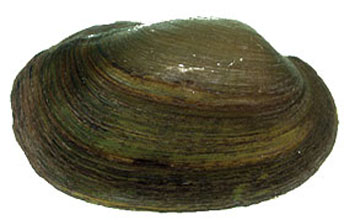Lilliput
Scientific name: Toxolasma parvum

Cover photo credit: Environment Canada
Status
Threatened
Threatened
means the species lives in the wild in Ontario, is not endangered, but is likely to become endangered if steps are not taken to address factors threatening it.
Date added to the Species at Risk in Ontario List
June 27, 2014
Read the assessment report (PDF)
What it looks like
Lilliput are small freshwater mussels that typically grow to about 25 mm long, though they can reach twice that length.
The shell is oval or egg-shaped and thick, with a smooth outer surface. Younger mussels are pale yellow, green, or gray, while larger ones are blackish-brown.
These mussels live 5-6 years, with some individuals living as long as 12 years.
Where it lives
Unlike many at-risk mussels, lilliput are found in a variety of soft river bottoms, such as mud, sand, and silt. Lilliputs burrow in these soft materials to filter-feed. This mussel is very sensitive to changes in water quality.
Like most mussels, lilliput females expel their larvae in the gills of host fish, where they live as parasites before forming into free-living mussels. Likely hosts are Johnny darter, white crappie, bluegill and green sunfish.
Where it’s been found in Ontario
This mussel is found in a small number of rivers flowing into Lake St. Clair, Lake Erie and Lake Ontario, as well as two wetlands near the western end of Lake Ontario.
Since 1997, the lilliput has been documented in the Sydenham River, the lower Thames River (Baptiste Creek), Ruscom River, Belle River, Grand River, Welland River, 20 Mile Creek (Jordan Harbour) and Hamilton Harbour (Sunfish Pond).
What threatens it
The greatest threats to this mussel are pollution from urban and agricultural sources, increased sediment in their rivers, and invasive zebra and quagga mussels, which have significantly altered the ecosystem of the Great Lakes. An invasive fish, the round goby is linked to the decline of the Johnny darter, which is believed to be a host for the lilliput.
Action we are taking
Threatened species and their general habitat are automatically protected under Ontario’s Endangered Species Act, 2007.
Recovery strategy
A recovery strategy advises the ministry on ways to ensure healthy numbers of the species return to Ontario.
Read the executive summary and the full document (January 25, 2023).
Government response statement
A government response statement outlines the actions the government intends to take or support to help recover the species.
Read the government response statement (October 25, 2023)
What you can do
Report a sighting
- Report a sighting of an endangered animal or plant to the Natural Heritage Information Centre. Photographs with specific locations or mapping coordinates are always helpful.
Volunteer
- Volunteer with your local nature club or provincial park to participate in surveys or stewardship work focused on species at risk.
Be a good steward
- Invasive species seriously threaten many of Ontario’s species at risk. To learn what you can do to help reduce the threat of invasive species, visit:
- Private land owners have a very important role to play in species recovery. You may be eligible for stewardship programs that support the protection and recovery of species at risk and their habitats.
- You can help improve mussel habitat and keep Ontario’s water safe and clean by maintaining natural vegetation next to creeks and rivers. The roots of plants reduce erosion and can stop soil from washing into the river. Fence off streamside areas to keep cattle (and their manure) out of the water. There are many other things that you can do to help reduce soil erosion and you might be eligible for funding assistance. For more information, visit the Ontario Soil and Crop Improvement Association: www.ontariosoilcrop.org.
Report illegal activity
- Report any illegal activity related to plants and wildlife to
1-866-MOETIPS (663-8477) (6638477 (663-8477)) .
Quick facts
- Ontario is the only place in Canada where this species of mussel has been found.
- Lilliput larvae are clustered into packages called “conglutinates” when released, and somewhat resemble insect larvae. When a fooled fish bites down on one of these packages, the larvae burst out and attach to the fish gills where they live as parasites and consume nutrients from the fish until they transform into juvenile mussels and drop off.
- Lilliput shells were first observed in Ontario in 1913. However, the first live specimen in Ontario was not found until 1991 in the Sydenham River.